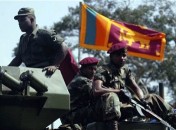War crimes: Tyrants are right to fear the new technology witnesses
There was much in the documentary to commend. Its recognition that Tamil Tigers were prepared to use as pawns the civilians they claimed to represent; the forensic way it explored the UN’s unconscionable retreat as the conflict worsened; the wide range of experts interviewed to provide ballast and balance. But the real significance of the film emerged from the extraordinary, almost unwatchable, footage of the horrors of those grim weeks, much of it recorded on mobile phones
In Sri Lanka, Libya, Bahrain and elsewhere, human rights abuses are being recorded and the evidence is on the internet
Guardian / Observer UK Editorial, Jun 19, 2011
War crimes: The world has seen the evidence. Now we must act
The broadcast last week of Channel 4′s Sri Lanka’s Killing Fields documentary was a defining moment not just for the media, but for those who investigate war crimes. Chronicling the final bloody weeks in 2009 of the country’s civil war which claimed the lives of at least 40,000 Tamil civilians, it captured in sometimes grainy, often terrifying footage, the horrors of a nation violently divided.
There was much in the documentary to commend. Its recognition that Tamil Tigers were prepared to use as pawns the civilians they claimed to represent; the forensic way it explored the UN’s unconscionable retreat as the conflict worsened; the wide range of experts interviewed to provide ballast and balance. But the real significance of the film emerged from the extraordinary, almost unwatchable, footage of the horrors of those grim weeks, much of it recorded on mobile phones.
Not all the footage was taken by desperate people determined to record the crimes they were being forced to witness. One scene in the documentary, showing three people being executed, was apparently recorded on a mobile phone by a Sri Lankan government soldier as a trophy video.
True, the provenance of some of the footage can never be established, in part because those involved are dead, displaced or in hiding. As Channel 4 acknowledged, it is impossible in some cases to establish whether the footage was taken by a Tamil Tiger, Sri Lankan soldier or a civilian.
But the documentary appeared to provide compelling evidence that Sri Lankan government forces massacred prisoners, that civilian hospitals were shelled and that female Tamil fighters were sexually assaulted before being killed.
The shaky video captured on mobile phones represents a modern-day version of Goya’s Disasters of War prints, which recorded in harrowing detail Spain’s bloody battle with Napoleonic France and which were considered so shocking they remained unpublished for more than three decades after the artist’s death. David Cameron spoke for many who saw the documentary when he called for the UN to launch an investigation.
The Sri Lankan government’s initial response was predictable, with its defence ministry citing an expert claiming the footage had been manipulated. But its foreign ministry, aware of the mounting international outrage, has been noticeably more measured, suggesting action could be taken if any allegations were found to be genuine.
This is an important admission. Christof Heyns, the UN special investigator into extrajudicial killings in Sri Lanka, has said footage showing soldiers apparently executing civilians is authentic. Sri Lanka, having hosted part of the Cricket World Cup and keen to develop its thriving tourist industry, risks further tarnishing its image if it now refuses to examine the evidence.
There are important precedents here for what is happening in the Middle East. The Arab Spring owed much to the internet and the mobile phone; social networking sites nurtured, co-ordinated and shaped revolutions. But these instruments of modernity also bore witness to revolution’s ugly twin: government suppression – tanks sent in against protesters in Banias, Saudi snipers on the rooftops in Bahrain, tear gas in Tahrir Square.
So far, the allegations of war crimes committed in the name of the Sri Lankan government have not received the international attention they deserve. Sri Lanka, anxious to put the trauma of its civil war behind it, has yet to provide a full account of its role in alleged atrocities, and the world’s attention has been elsewhere. But what happened in Sri Lanka in those nightmarish days of 2009 has put governments everywhere, dictatorships and democracies alike, on notice. When suppression mutates into war crimes, they will be recorded on mobile phones and disseminated across the web. It will be increasingly difficult for bodies such as the UN to refuse an investigation when billions of people can access compelling evidence of crimes at the click of a mouse .
This is an important shift in accountability. As we report today, lawyers in Libya’s rebel-held city of Misrata believe they now have sufficient evidence for the International Criminal Court to convict the Gaddafi regime of crimes against humanity. The evidence is in the form of orders signed by Gaddafi and his sons instructing the security forces to suppress revolts at all costs.
But new technology means such paper trails are no longer the only way of bringing tyrants to book. In the future, the revolution will be filmed. So, too, will war crimes. courtesy: Guardian UK
